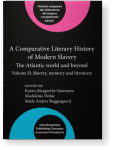Chapter 2
“Some slave is rotting in this manorial lake”
Fictions of memory in Derek Walcott and Édouard Glissant
Derek Walcott and Édouard Glissant are two major Caribbean authors of the twentieth century who are
seldom studied in a comparative approach, despite overarching similarities that provide insights into Caribbean
literature as a whole. Their approach to a fundamental aspect of history in the Caribbean, that of slavery, is similar
in that they perceive these plural histories to be incomplete, fragmentary, and lacking positive meaning. For both
authors, retracing the history of slavery means memorializing it through fiction (in the sense of literary invention),
used as a tool for questioning dominant narratives and traditional historical epistemologies. They both create
idiosyncratic, sometimes voluntarily anachronistic, memories of slavery to represent silenced voices and provide a
reconciliatory vision of the past.
Article outline
- Memory and history in the Caribbean
- The void of history
- Reclaiming history
- Building meaning through fiction
- Conclusion: The value of symbolic memory
- Author queries
-
Notes
-
References
This content is being prepared for publication; it may be subject to changes.
